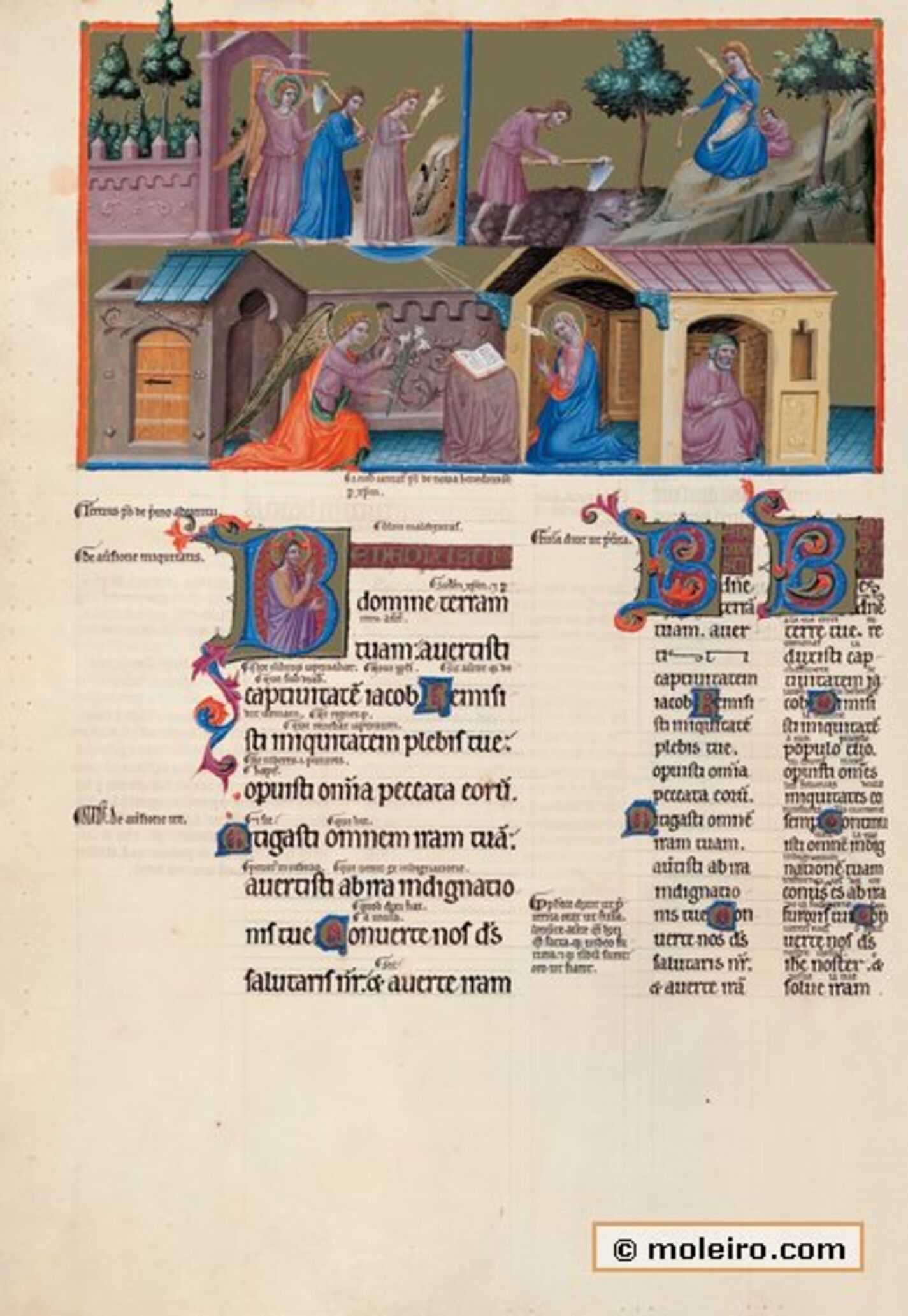Verse 3 of psalm 84, which refers to the redemption of the sins of Israel and the wickedness of humanity (v. 3, Remisisti iniquitatem plebis tuae: operuisti omnia peccata eorum. // Thou hast forgiven the iniquity of thy people: thou hast covered all their sins), is the one that matches the images chosen for the two registers in this miniature best, although the idea is repeated later in relation to the punishment meted out to the first humans (v. 6, Nunquid in aeternum irasceris nobis? Aut extendes iram tuam a generatione in generationem? // Wilt thou be angry with us for ever: or wilt thou extend thy wrath from generation to generation?). Consequently, the upper register portrays Adam and Eve being expelled from Paradise and threatened by an angel with a green nimbus holding a sword of fire converted into a reddish sword. Hence the sin of the first parents has certain consequences. We can see the architectural boundaries of a paradise depicted as a garden where the growth of the vine will not be hindered. Trees too grow in this idyllic location that contrasts with the desert or arid lands usually depicted in the images. The solution shows elements in common with the English part depicting this theme too (f. 1). Unlike the English workshop, which covered Adam and Eve’s genitals with leaves difficult to identify, the Catalan workshop dresses both Adam, now carrying a hoe or mattock, and Eve, transformed directly into a spinner, in ankle-length tunics. In the course of time and wearing different habits, we will see the first inhabitants of earth about their work. The colours of their garments have changed. Adam now works the earth in a short tunic whilst Eve, on a rock, spins and watches over her two sons, Cain and Abel. The latter lies on her lap still wrapped in the swaddling clothes used to stop small children from moving about whilst his older brother reveals his jealousy, the start of conflict amongst men. Ferrer Bassa adapts the insular workshop’s portrayal of these events on f. 1 to the 1300 style. In doing so, the condemnation to work and the presence of the descendants confirms the relationship between the two parts of the book and the attention paid by Ferrer Bassa to his predecessors’ work. The links are very suggestive, particularly if other representations of the theme are taken into account which, in the realm of the Crown of Catalonia and Aragón, require the Aragonese murals at Santa María of Sigena (MNAC, Barcelona) to be mentioned too, amongst other works.
The lower register, dedicated to the Annunciation, implies the opening of the path closed previously, i.e. the redemption after the fall (v. 7, Deus tu conversus vivificavis nos... // Thou wilt turn, O God, and bring us to life; v. 8, Ostende nobis Domine misericordiam tuam: et salutare tuum nobis // Shew us, O Lord, thy mercy; and grant us thy salvation). This structures the old Eve-Mary relationship appearing earlier on f. 109v. The Virgin, transformed into the axis of the Incarnation and the salvation of humanity, restores mankind’s lost dignity, thanks to the seed that bears fruit on earth and is identified with Christ (v. 10-14, and particularly, in relation to the Incarnation, v. 10 Verumtamen prope timentes eum salutare ipsius: ut inhabitet gloria in terra nostra // Surely his salvation is near to them that fear him: that glory may dwell in our land) shown blessing in the capital B (“Benedixisti”) alongside the main miniature. The blessing of Christ, facing the same way as the angel, combines with the angel’s greeting. Ferrer Bassa’s scene re-works the theme in several respects. It includes a dynamic angel in an orange cloak who seems to have just landed on earth. The terrace in the building on the left behind him suggests his movement and descent to the place where he is now, taking into account that the wooden doors in the dwelling that lead onto the inside patio are well and truly closed. Once inside the intermediate area, the heavenly ambassador offers the lilies to the Virgin and speaks to her. Lying between them upon a small item of furniture completely covered in an embroidered cloth is a large book with imaginary writing. Mary, kneeling tensely in the house, consents to receive a very aerodynamic Holy Ghost whose face can now be seen frontally, and does so with open hands. Situated in the same house, but in a different room, is St Joseph, referred to at some point as the guardian of the Annunciation. His presence in this theme in the Gothic era is most unusual. Not so in Romanesque times, however, where this was quite common and very popular in Catalonia. Hence, the resolution of this scene returns us to times prior to 1200 and seems very unusual, although it can be duly compared with others that it undoubtedly gave rise to. Despite the similarities with Arnau Bassa’s Annunciation in the Hours of Maria of Navarre, Ferrer’s Annunciation has a unique, plastic meaning. Its graphic approach is more austere and conceptual than the scene by his son who was always more concerned about decorative aspects and tender, gloomy emotion than by the spatial realism his father was fond of.
